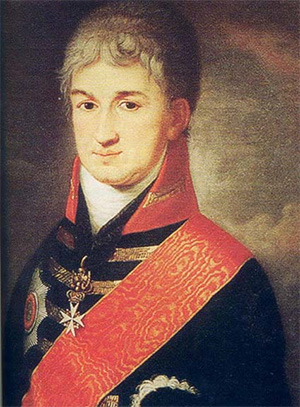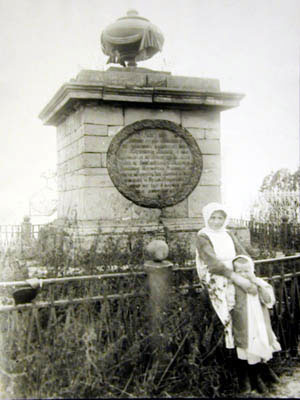
Rezanov: Russian 'Romeo' foresaw an empire in Alaska, California and HawaiiBy DAVE KIFFER August 01, 2016
But few Alaskans are aware of the crucial role that Nikolai Rezanov played in the founding of Russian America. When Rezanov’s name does come up in modern times, it is often in relation to a relationship that many historians call North America’s version of “Romeo and Juliet.”
Rezanov was born in the Russian capital of Saint Petersburg on March 28, 1764. His father was a Russian civil servant who had served for many years in Irkurstk, the capital of eastern Siberia. Rezanov was a bit of a child prodigy, according to Owen Matthews 2013 book “Glorious Adventures: Nikolai Rezanov and the Dream of A Russian America.” By the age of 14, Rezanov had mastered five languages and joined the Russian army, serving in the Izmaylovsky Regiment in Saint Petersburg . He resigned as a Captain at age 19. He then served as a court officer for several years in Pskov, a city in Western Russia near the border of Estonia. By the age of 27, he was back in Saint Petersburg, working for the private secretary to Empress Catherine. He quickly caught the attention of Platon Zubov, one of the lovers of the Empress and her most powerful advisor. Zubov was interested in the Siberian fur trade and soon, Rezanov was working as a go between between Zubov and Grigory Shelikov an important merchant in Irkustk. Shelikov was interested in promoting his nascent colony in the Kodiak Islands and Rezanov and Zubov convinced Empress Catherine to significantly support the venture. The Shelikov-Golikov Company was the forerunner of the Russian America Company. In 1794, Zubov sent Rezanov to Irkutsk to oversee his investments. By 1795, Rezanov had married Shelikov’s 15 –year-old daughter and had become a director in Shelikov’s company. When Shelikov died later that year, he left the company to his wife, Natalia, rather than his son-in-law and Rezanov felt marginalized. He sought the permission of Empress Catherine to start a competing company in the region and to expand that company to Russian Alaska. The empress approved Rezanov’s charter but then she died. Rezanov then went to work to get the support of her son Tsar Paul I and he achieved that support shortly before Tsar Paul I was a assassinated in 1799. In the meantime, Natalia Shelikov had received the Tsar’s approval to reorganize her company as the Russian American Company. But, the Tsar established Rezanov as his official liaison with the RAC, effectively putting him in charge. The RAC was granted a 20-year trade monopoly for Russian America north of the 55 latitude, which is roughly the current southern border between Southeast Alaska and British Columbia. The monopoly also included potentially lucrative trade with Kamchatka, China and Japan. As a government employee, Rezanov was not allowed to be a director of the RAC but he was allowed to amass significant shares in the company, as were Tsar Paul and his successor Tsar Alexander I. The fact that the trade monopoly could also be revoked essentially gave Rezanov veto power over the operations of the Russian American Company. The first step in establishing the Russian America Company control was moving trading and military vessels from northwestern Russia to North America. Rezanov was one of the leaders on what was called the First Russian Cicumnavigation, a three-year ocean voyage from the Baltic Sea around the tip of South America , across the Pacific to Hawaii and then Japan and eventually back to Alaska. The lengthy visit to Japan did not result in opening up that country to Russian trade, but the visit to the then Kingdom of Hawaii inspired Rezanov to think about expanding the Russian empire to that area. According to Richard Pierce’s 1965 book “Russia’s Hawaiian Adventure,” Rezanov convinced Russian officials to consider establishing trading posts in Hawaii, which indeed happened on Kauai a decade later. Unfortunately, the Russians chose to back a Kauaian leader who was seeking to unify control of all the islands. When that leader lost, in 1816, the Russians were driven out of Hawaii. In 1805, Rezanov was ordered by the Russian government to take up residence in Alaska and to oversee operations. There had been a sharp dropoff in the main industry, seal fur harvesting, and, according to Matthews, Rezanov took steps to lower the harvest in order to ensure its long term survival. Rezanov also became concerned over the colony’s ability to sustain itself long term as much of the supplies it needed still came from Siberia. Supply ships were often lost in the stormy north Pacific and the colonists in Kodiak and Sitka often suffered from scurvy and starvation. On February 26, 1806, Rezanov sailed to Spanish California hoping to set up trading posts that would allow California food and supplies to be sent to Alaska. What he found, in San Francisco, was love. Rezanov’s wife, Anna Shelikova, had died in childbirth in 1801, but when he tried to get permission to marry the beautiful daughter of a Spanish leader in California, his efforts created an international intrigue involving the monarchs of Spain and Russia and the leaders of the Catholic and Russian Orthodox churchs. The star-crossed relationship is still being celebrated two hundred years later. Rezanov’s desperation over the potential fate of the Alaskan colony’s caused him to basically go to California without the support of his government and with the knowledge that Spain had closed all the Califorinia ports to trade with any outside countries. So, when Rezanov and his ship pulled into San Francisco Bay on March 27, they were very unwelcome. Fortunately, their somewhat dire straits appealed to the humanitarianism of the Spanish Comandante Don Jose Dario Arguello, who hosted Rezanov for six weeks and allowed the Russians to fill up their ship, the Juno, with supplies to take back to Alaska. The 42-year-old Rezanov also courted Arguello’s daughter, Concepcion “Conchita” Arguello. Conchita Arguello was “the universally recognized beauty of Nueva California,” according to Matthews. He portrays her as a self-aware young woman who most likely saw Rezanov as her ticket out of the provincial, barely settled, backwaters of Alta California. For his part, Rezanov was clearly interested in an economic union, but saw his relationship with Conchita also having significant political advantages, according to Matthews. It was clear though that love was part of the mix. But within six weeks, she had agreed to marry Rezanov, although she didn’t leave with him when he returned with his supplies to Alaska. The major sticking point was that Rezanov needed permission to from both Russian political and religious leaders to remarry. He was also forced to send letters to the Pope and the King of Spain seeking their support for the marriage as well. But nothing moved quickly and Rezanov needed to get supplies to the starving colonists. To complicate matters, Rezanov had signed an informal treaty with the Spaniards in California and now he had to get back to Saint Petersburg to convince the Russian government to support it. In May, he sailed north and arrived in Sitka on June 8. After spending a few weeks there, he began the longer ocean and overland journey to Saint Petersburg in order to press his case, for both his treaty and his marriage. He didn’t make it. First he was delayed when he unilaterally declared “war” on Japan by sending a Russian warship – without the permission of the government – to attack and open up a port on the then Japanese island of Sakhalin. Then he resumed his journey, making it as far as Krasny Yar in western Siberia where he succumbed to fever and exhaustion on March 8, 1807. Rezanov's dream of expansion into California led the Russians to establish Fort Ross in California in the decade after his death. Conchita meanwhile, waited patiently for word from Rezanov to arrive. When it never came, she chose to not marry, instead living out the rest of her life, until she died in 1857, as a nun. But the story of Nikolai and Conchita did not end there. Almost immediately, heroic poems were composed in their memory in both Russia and Spain. American author Bret Harte penned “Concepcion De Arguello in 1870. The first biography of Rezanov was published in 1906 on the anniversary of Rezanov’s meeting Conchita. Most notably, a rock opera was written in Russia in the 1970s, loosely based on the story of Nikolai and Conchita, called “Juno and Avos” the names of two of Rezanov’s ships. It began being performed in 1981 and continues to draw large crowds in Russia to this day. An album of songs from the “rock opera” has sold more than 10 million copies.
Contact Dave at dave@sitnews.us Dave Kiffer ©2016
To comment, Readers now have the option to provide Comments, Opinions, & Responses on the new easy to use SitNews' auto-post webpage or... Use the FaceBook response section provided below.
Publish A Letter in SitNews Read Letters/Opinions
|
||||


